The Canon EF 40mm f/2.8 STM is one of the oldest lenses in my camera bag. It has outlived many fancier, more expensive lenses. And I use it almost every day.
So what is it that makes this such a great little lens? And should you make room for one in your camera bag? Read on to decide for yourself.
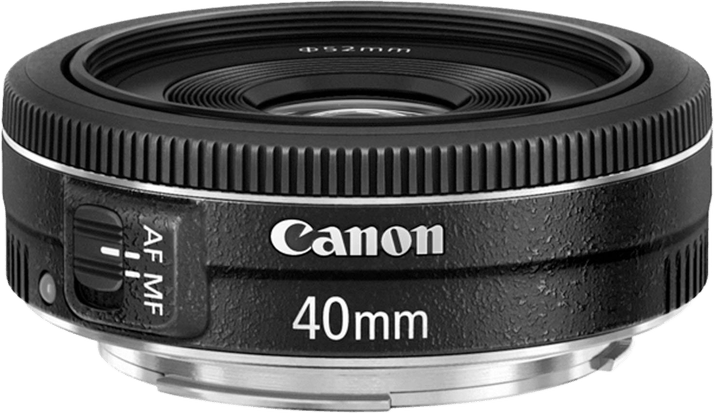

| Brand |
Brand
Canon
|
| Maximum Aperture |
Maximum Aperture
f/ 2.8
|
| Focal Length Range |
Focal Length Range
40 mm
|
| Image Stabilization |
Image Stabilization
|
Today, it’s the smallest lens available for Canon DSLRs along with the almost-equivalent crop sensor lens, the EF-S 24mm f/2.8 STM. The latter was my first lens ever. So it seemed reasonable to purchase the 40mm when I switched to full frame cameras.
Besides the convenient size, the 40mm is excellent optically. It outperforms its closest alternative, the 50mm f/1.8, even at f/2.8.
Another advantage it has over the nifty fifty is better close-up performance. Even by default, it’s capable of slightly better magnification. But with extension tubes, the gap broadens.
The 40mm, with its shorter base focal length, is a more effective macro lens. And it retains sharpness much better than the 50mm at close focusing distances.

As a fairly cheap lens, its packaging is moderate. Besides the lens (with both caps provided) and the user manual, there’s nothing else in there.
The ES-52 official lens hood is available separately. But I don’t recommend purchasing it for several reasons.
It has identical no-brand alternatives for much cheaper. It also does almost nothing to protect the lens or block sunlight with its minuscule size. Luckily, the lens’s optical performance makes it largely unnecessary.
This lens is for everybody who basically wants to replace the kit lens that came with their camera. Its size is ideal for quick grab-and-go shoots, photojournalism, street, documentary, and even event photography.
Even if it can’t entirely hide the fact that you’re carrying a bulky DSLR, it makes it somewhat less intrusive and frightening. This helps with portraits, especially candid shots.
It also helps to get into places where a large camera wouldn’t normally be allowed. I got away with shooting concerts on several occasions with this lens and my 5D camera.

Still, the 50mm f/1.8 STM gives you similar advantages, even if it’s a bit larger. But after using both for years, there are several reasons I chose the 40mm.
First, that small size difference does matter. And the 40mm has the advantage there. Second, I don’t shoot portraits as often as street photography. Corner sharpness is key with the latter, so the 40mm won again. Plus, it’s a little bit sturdier built.
But I don’t recommend this lens for crop sensor cameras. The 40mm focal length is not very convenient on a crop sensor, at least in my experience. Choose the 24mm f/2.8 STM instead, which is the 40mm’s little sibling.
The Canon EF 40mm f/2.8 STM is primarily for full frame EF-mount cameras. These are the Canon EOS 6D, EOS 5D, and EOS 1DX/1Ds series of digital cameras and all of Canon’s 35mm film cameras since 1987.
But the lens will work perfectly on crop sensor EOS bodies (such as the 7D, 10D-90D series, and all the Rebels). It can also be adapted without loss in autofocus speed to Canon’s full frame mirrorless R bodies (currently the R, RP, R6, and R5).
I actually used it to test and review the EOS RP, as I found them to be a great, small combo.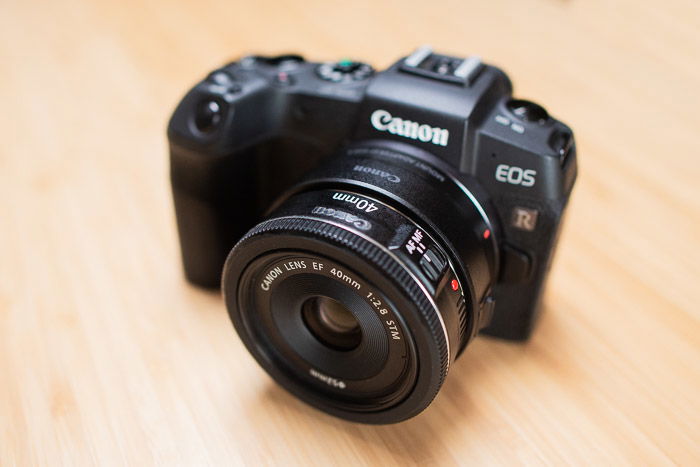
It will work just fine on Canon’s crop sensor mirrorless EF-M-mount cameras (e.g., the M100, M50, M5, and M6). There’s just a slight drop in autofocusing speed.
You can also attach any EF-mount adaptor currently used for this lens. These include adaptors to Sony E-mount, Fujifilm X-mount, Micro Four Thirds, Nikon Z-mount, Leica L-mount, and more.
Autofocusing speeds and reliability of these off-brand adaptors depend on the quality.
The 40mm is among the best Canon lenses in this focal length range. Right from f/2.8, it provides excellent sharpness from corner to corner. It doesn’t get better beyond f/4.
As I mentioned, it retains sharpness with extension tubes at close focusing distances really well. In most aspects (other than the aperture), it’s in the same league as the EF 50mm f/1.2L, which says something.
The distortion level is excellent, which is to say it’s barely noticeable on full frame cameras. It’s also easy to correct if you want 100% straight lines everywhere. That’s because it’s a very simple barrel-type distortion with no weird deformations.
Its out-of-focus background looks excellent. It has pleasant smoothness, no ugly transitions, and minimal longitudinal chromatic aberration. Chromatic aberration on contrasty edges is also well-controlled. It’s significantly better than the 50mm f/1.8.
Flares don’t pose much of a problem. They do show up, but they’re unobtrusive and don’t result in a loss of contrast.
The Canon EF 40mm f/2.8 STM has a great autofocus. But it has very limited manual focusing capabilities.
Its autofocus system is quick and very accurate. And it’s responsive in very low light, too. It’s better than you’d expect from an f/2.8 lens and better than the EF 24-70 f/2.8 II zoom lens at 40mm.
My lens has never had any issues. I’ve never even had to make micro-adjustments. This is in stark contrast with the 50mm f/1.8 STM. I had two faulty samples before getting a consistent one. And even that one had to be micro-adjusted.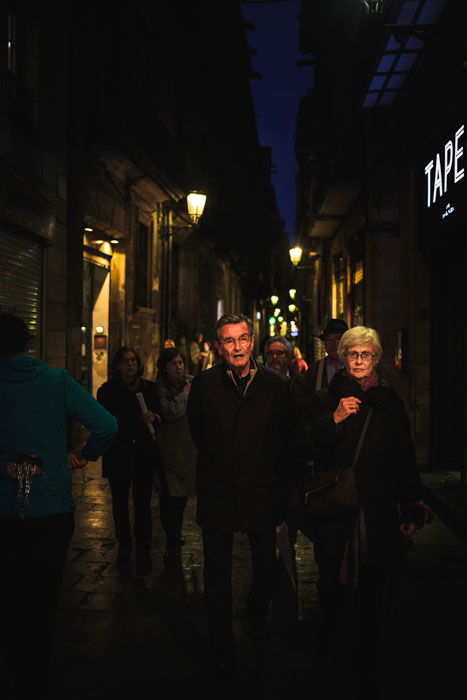
The 40mm pancake was one of the first lenses to include a stepping autofocus motor instead of the traditional USM motor, hence the “STM” mark in the name. This technology has helped with smooth continuous focusing. It’s a great improvement for video shooters.
But this also means the manual focusing ring and the lens elements are no longer physically connected. This is a bummer for those who want to focus manually.
You can’t focus when the camera is turned off, even in manual focus. The ring is also almost non-existent. It’s a thin plastic piece right at the front of the lens. So no manual-focus magic here.
There is no full-time manual focus override. And as expected at this size, there is no distance scale. When focusing, the front element extends out of the barrel but doesn’t rotate. Its minimum focusing distance is 0.3 m.
The 40mm f/2.8 STM pancake lens is mostly made of plastic, except for the lens mount, which is metal.
Despite this, it seems rather solid. And it has been taking hits throughout years of work and travel. There are marks and scratches, of course. But it doesn’t have any reliability issues.
It doesn’t have weather sealing, though. And with the moving front element, I never wanted to test how true that really is. This is not a rain or dust-friendly lens.
The only thing occupying the side of the lens is the manual focus and autofocus switch (MF/AF).
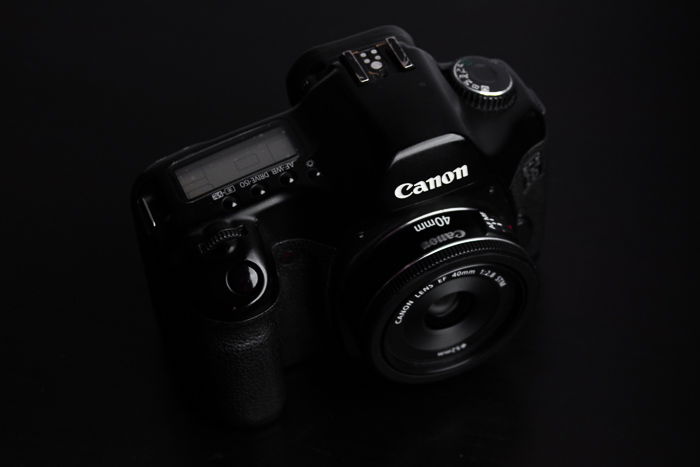
It has a 52mm filter thread. Filters of this size are cheap and widely available. Be aware that the autofocus motor doesn’t tolerate more than one filter in the long term. With two filters, it makes weird, whirring sounds, presumably due to the weight.
The lens is 68mm in diameter (not much wider than the lens mount itself) and 23mm long. It really is tiny. But at 130 grams, it feels quite dense.
You can attach several extension tubes and still get very usable results in image quality and handling. But you’re likely limited to focusing by getting closer or farther away because of the poor manual focus. That’s not an issue with macro rails or free hand-holding.
One alternative to the 40mm pancake is the 50mm f/1.8 STM we mentioned before. It’s the newest edition of the nifty fifty.
It’s slightly cheaper and more than a stop faster. But the 40mm has a slightly better image and build quality, all in a smaller package.
If you’re searching for a crop sensor alternative, look no further than the EF-S 24mm f/2.8 STM.
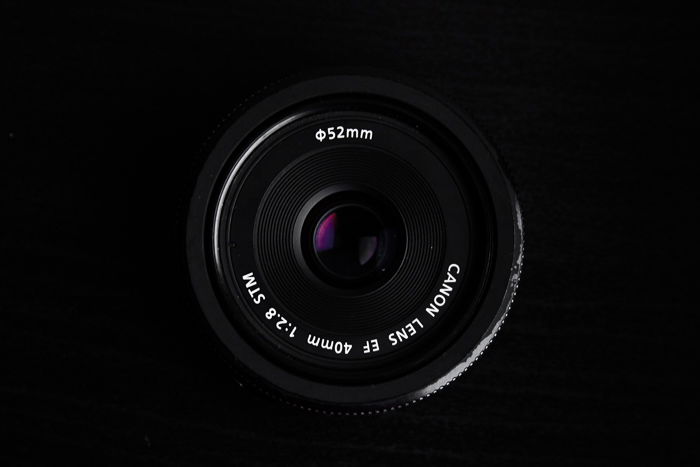
The 40mm f/2.8 STM doesn’t take up much space. But it gives you excellent results. It’s a lens that can be your long-term partner in photography. It has definitely been mine! You can read about using this lens for low-budget macro photography.
| Measurement |
Measurement
Score
|
| Build and Handling |
Build and Handling
|
| Focusing |
Focusing
|
| Image Quality |
Image Quality
|
| Miscellaneous |
Miscellaneous
|
| Value for Money |
Value for Money
|
| Total Score |
Total Score
|

